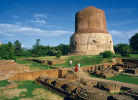Manikarnika Ghat, Varanasi
Manikarnika Ghat is one of the important ghats of River Ganges. This ghat is famous for being the sacred cremation ground for Hindus. This is a unique place to visit in Varanasi. However, if you wish to learn the complete beauty of Varanasi, a boat ride along the ghat is very essential.
Location of Manikarnika Ghat
Manikarnika Ghat is located between Scindia Ghat and Dashashwamedh Ghat. The ghat is located in Ghastiola road.
- Distance between Manikarnika Ghat and Dashashwamedh Ghat 950 m (5 minutes)
- Distance between Manikarnika Ghat and Kashi Vishwanath Temple 400 m (2 minutes)
- Distance between Manikarnika Ghat and Varanasi Cantt Railway station - 6.9km (35 minutes)
- Distance between Manikarnika Ghat and Varanasi airport 24.9 km (59 minutes)
- Distance between Manikarnika Ghat and Sarnath 8 km (31 minutes)
- Distance between Manikarnika Ghat and BHU 4.9 km (25 minutes)
History of Manikarnika Ghat
This is one of the oldest ghats of the river. The first ever literature reference of this ghat belongs to 5th century AD. There is no concrete proof to by whom and when the ghat was built. According to legends, this ghat is associated with the mythology of death of Sati (Parvati).
The Manikarnika Shrine as a Shakti Peeth
According to legends, Sati’s father conducted a large ritual and invited every significant person in the world, except his daughter and his son-in-law (Lord Shiva). Humiliated by the act, Sati fell into the burning pyre and killed herself. Lord Shiva took the burning body of Sati and walked around the world. To end his sorrows, Lord Vishnu set his chakra to cut Lord Sati’s body into 51 parts. Each part scattered at different destination. Each place where a part of Sati fell is called Shakti Peeth. It is said that Sati’s ear ring fell near River Ganges, and it became Manikarnika (ear ring).
At each Shakti Peeth, a temple is erected in later years. The shrine of Manikarnika holds the deity Manikarni or Vishalakshi.
Significance of Manikarnika Ghat
According to Hinduism, the death is the beginning of an eternal journey. To break the cycle of re-birth (to be born back again); the soul has to reach ultimate salvation. It is believed that if a person’s cremation takes place in Manikarnika Ghat, the soul will attain complete salvation.
The well near the ghat is assumed to be built by Lord Vishnu to please Lord Shiva and Parvati to grant his wish. Today, the well is assumed to have the power to grant wishes to the devotees.
Many old Hindus from around the world visit Varanasi and stay back to get used to the concept of death in Manikarnika. They believed that accustoming to the cycle of life will make death less painful and insignificant. At Manikarnika Ghat, the death is not feared, but celebrated and accepted. This ghat is seen as the gateway to eternity in heaven.
Tourist Attractions in Manikarnika Ghat
Most people do not assume Manikarnika to be a tourist attraction. However, explorers and adventure lovers who want to experience the mystic beauty of the land visit the Manikarnika Ghat.
You can always find a couple of bodies being burnt. It is said that more than three hundred bodies are burnt every day. Tourists can hire boats from Dashashwamedh Ghat to go pass Manikarnika Ghat and watch the rituals. Although there is no rule pertaining to it, common humanity dictates not to take pictures and make an exciting vacation out of Manikarnika. After all, it is a family’s final goodbye to a loved one.
Best Time to Visit Manikarnika Ghat
If you are looking for spotting cremations, the best time to visit is between 8 am and 7 pm. Every day, more than 300 bodies are cremated in this ghat. Thus, you can easily catch a cremation ceremony. However, finding boats early in the morning and by sunset is quite hard due to heavy demand.
In terms of climate, the winter is the right time to visit Manikarnika Ghat. The winter starts in October and ends in March. The worst time to visit is during peak monsoon, which starts in July and ends in August.
How to Reach Manikarnika Ghat
From airport, railway station, and bus stand, you can reach up to Godolia Chowk by hiring auto rickshaws, cabs or cycle rickshaws. From the Chowk, you ought to walk towards Manikarnika Ghat. On the other hand, you can reach Dashashwamedh Ghat or Scindia Ghat and hire a boat to ride along the Manikarnika Ghat. No vehicles are allowed beyond the Godolia Chowk.











